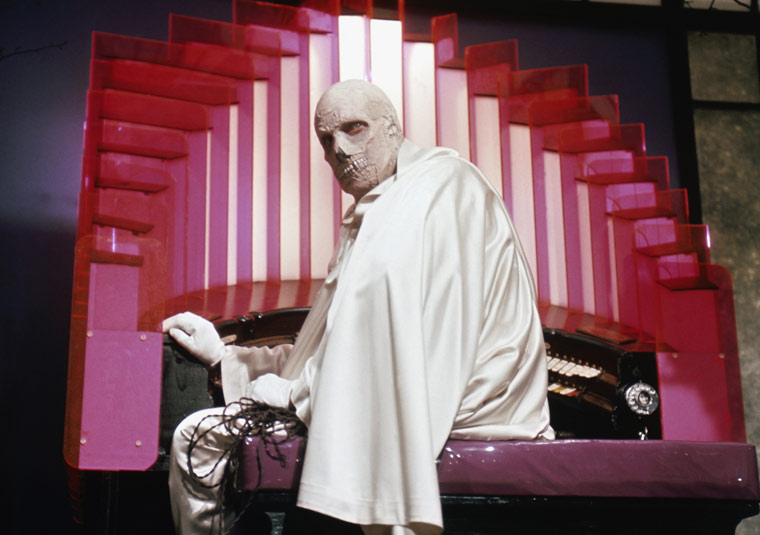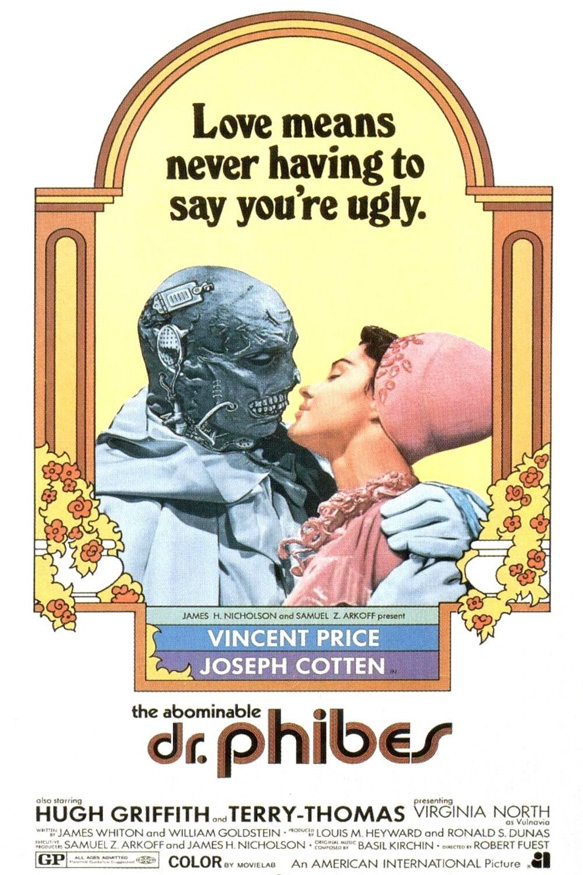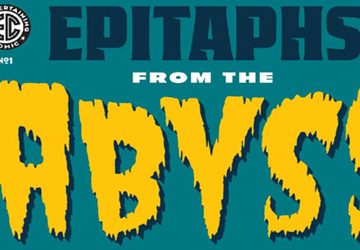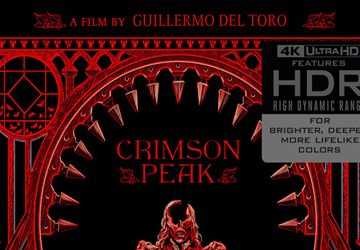In 2016 fright cinema fans celebrate the 45th anniversary of the portrayal of one of Vincent Price’s (House on Haunted Hill 1959, Masque of the Red Death 1964), most notable villains, The Abominable Dr. Phibes. Released on May 18th, 1971, the British film starred Joseph Cotten (Citizen Kane 1941, Soylent Green 1973), Virginia North (Some Girls Do 1969, On Her Majesty’s Secret Service 1969), Hugh Griffith (Ben-Hur 1959, Oliver! 1968), and Terry-Thomas (It’s A Mad, Mad, Mad, Mad World 1963, The Vault of Horror 1973). With beautiful cinematography from Norman Warwick (Dr. Jekyll & Sister Hyde 1971, Son of Dracula 1974), the film was written by James Whiton (Voyage to the Bottom of the Sea 1967, Dr. Phibes Rises Again! 1972) and William Goldstein ( Dr. Phibes Rises Again 1972, The Amazing Dobermans 1976), as well as directed by Robert Fuest (Dr. Phibes Rises Again 1972, The Devils Rain 1975). Combined dark humor, murder, horror, and mystery, The Abominable Dr. Phibes is worthy of deeper examination all these years later.
- The Abominable Dr Phibes still
The story follows Dr. Anton Phibes who was a famous organist who loved his wife more than life itself. When she was diagnosed with a terminal condition, a team of nine surgeons tried to save her, but she died on the operating table. Enraged, Dr. Phibes faked his death and vowed to exact revenge on the nine surgeons in the form of the Curse of the Pharaohs: Boils, Bats, Frogs, Blood, Hail, Locusts, Rats, Beasts, Death of the First Born, and finally, Darkness. “Nine killed her. Nine must die!”
With an estimated budget of £300,000 (UK), The Abominable Dr. Phibes was shot from November 2nd, 1970 through January 1971. For a vivid effect, the entire film was shot in and around London at the “thirties era” sets at Elstree Studios in Hertfordshire. The cemetery scenes were shot in Highgate Cemetery, and the exteriors of Phibes’ mansion were shot at Caldecote Towers at Immanuel College on Elstree Road. After its run through the theaters, The Abominable Dr. Phibes grossed over approximately $3,000,000 (US), making it a financial smash and spawning the 1972 sequel, Dr. Phibes Rises Again! There were talks and titles of other potential sequels, but none ever bore fruit. William Goldstein recalls writing the character of Anton Phibes: “Phibes is not a common murderer. He considers himself the Death Geometer to the universe. He wishes only to return to the Eden that he knew with his wife. When that’s thwarted, there is a price to pay, a price that is commensurate [with the enormity of the crime], but always in his inimitable style.” (The Complete Films of Vincent Price 1995)
- The Abominable Dr Phibes still
Very few actors could bring as much to a Horror performance as Vincent Price. Because of Anton Phibes’ physical deformities, he can only speak through a special microphone that he himself designed utilizing his “knowledge of music and acoustics.” Thus, all of Price’s lines were dubbed in through studio recordings. Vincent Price recalls how he proceeded to play Phibes: “[Now] Phibes is an entirely different thing. Phibes is all inside, seething and boiling, and you can’t do too much of that because movies are too facial, so it all has to be sublimated. I have to do a lot with my hands and eyes.” (The Complete Films of Vincent Price 1995). Virginia North portrayed the enigmatic Vulnavia. Never speaking a single line, she seems hopelessly devoted to following Phibes’ every whim, no matter how ghastly. It is never explained who or what Vulnavia is, but the original idea for the character was that she was another of Phibes’ clockwork devices, but simply looked more human, so that could explain her enigmatic nature. She appeared in a play in London called “Council of Love,” in which she was silent throughout her performance. “I played the daughter of the devil,” she told the Associated Press in 1971. “I’d go around and do terrible things. The people who made the movie saw me in the play and decided I was what they wanted. You might say I was ready made for the movie part.”
Genre fans may recognize the woman playing Phibes’ wife, Victoria, as B-Movie Queen Caroline Munro (Maniac 1980, Slaughter High 1986). Although her image was prominent throughout the film, she remains uncredited. Some characters provided comic relief. Dr. Longstreet (Thomas), for example, was a total pervert. He rushed his maid out so he could watch what was the 1930’s equivalent of a skin flick. When she is gone, Dr. Longstreet, brandy in hand, is cranking away…on his film projector, enjoying a scantily clad woman charming and dancing with a large snake. It is the funniest scene of the film. The other element of humor came from Inspector Trout (Peter Jeffrey: Midnight Express 1978, The Adventures of Baron Munchausen 1988), and how he dealt with solving the case of these mysterious murders. Dr. Visalius (Cotten) was originally to be portrayed by Peter Cushing (Horror of Dracula 1958, Shock Waves 1978), but he declined the role due to his wife’s poor health at the time. Vincent Price said Cotten was very uncomfortable doing his scenes, so he intentionally made a lot of funny faces to make him laugh. Cotten was also jealous that he had to remember lines while Price got to dub his in, to which Price replied: “Yes, but I still know them, Joe.” Apparently, Cotten was also just generally uncomfortable doing his scenes with Price, so Price would intentionally make him laugh.
- The Abominable Dr Phibes still
To gain more buzz for the film, The Abominable Dr. Phibes was advertised as Vincent Price’s 100th film, but that was a bit of an exaggerated fact. Also, it originally advertised in the U.S. with the tag line, “Love Means Never Having to Say You’re Ugly,” a parody of a famous line from Love Story (1970), out the previous year. However, that was replaced after the first week, as opening box office was disappointing and it turned out audiences had no idea what sort of film this was supposed to be. A new advertising campaign made it clear it was a Horror film, and afterwards it became a box-office hit.
Critically, The Abominable Dr. Phibes was very well received. One critic Christopher Null wrote, “One of the ’70s juiciest entries into the horror genre, The Abominable Dr. Phibes is Vincent Price at his campy best, a famous concert organist who is exacting revenge on the nine doctors he blames for botching his wife’s surgery, which ended with her death. Through a series of tortuous means that would make a Bond villain green with envy, the hideous Phibes is matched by Joseph Cotten as the doc at the end of the road. A crazy script and an awesome score make this a true classic.” From the Los Angeles Free Press May, 1971: “If the Phantom of the Opera had a dead wife whom he loved with the passion of Love Story and made up a shopping list like Adrian Messenger…He’d be Vincent Price as Dr. Phibes and he’d be in a better movie than any of the above…” From Chicago Today May, 1971: “It’s scary, stylish, wildly funny, and a menace to nail biters in the suspense department…Price has never been better. His performance is actually touching at times. I can hardly wait to see it again.”
- The Abominable Dr Phibes still
Simply put, The Abominable Dr. Phibes remains one of Vincent Price’s greatest films. Though the film is overall dated by today’s standards, the style of the sets, especially the organ, the bright colors, and Vincent Price’s final makeup, still have resonance after 45 years thus making it one of Horror’s most important pieces of history.
- Anglo-EMI Film Distributors










I saw this at the drive in when it came out. “Seven” and “Saw” owe this film a lot. William Goldstein signed one of his novelizations for me and started me praying for another sequel.